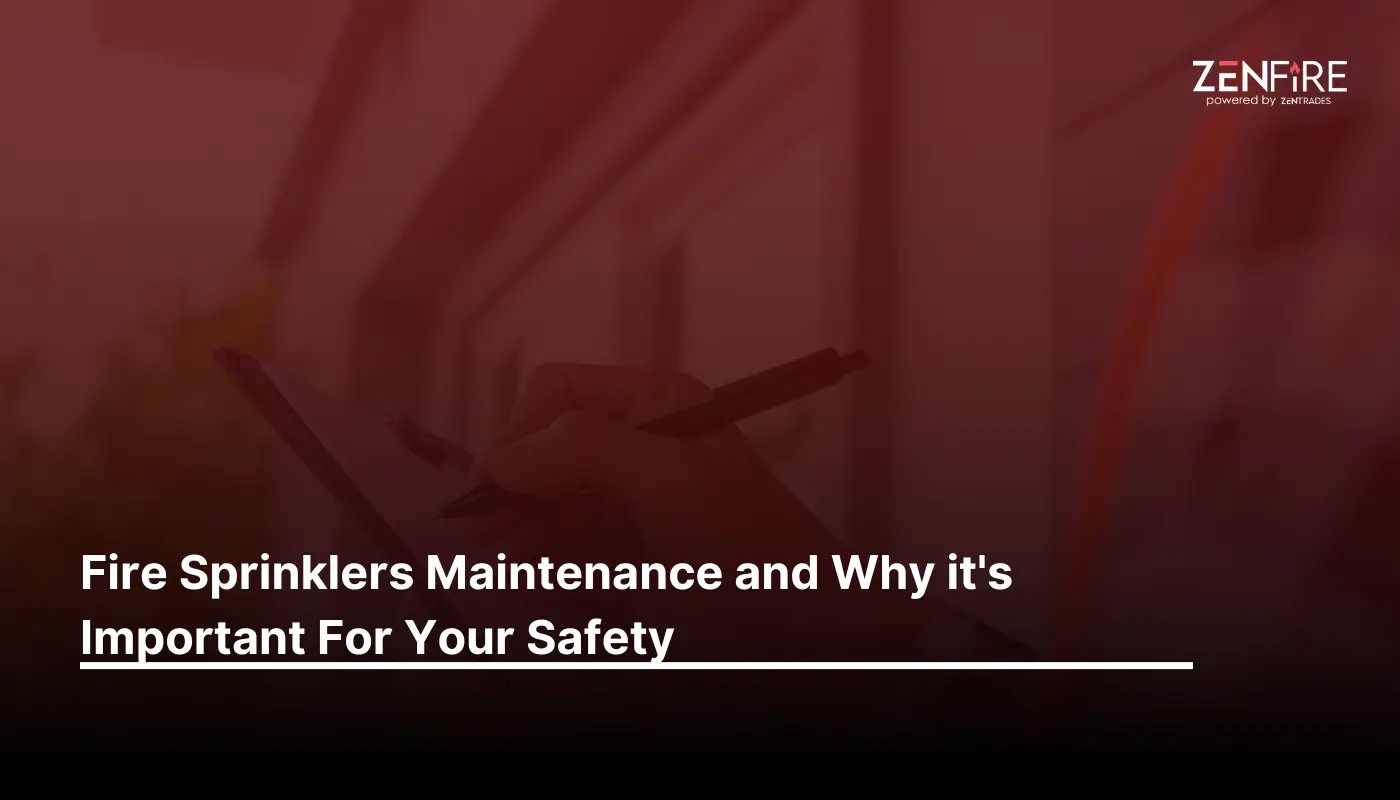Fire Sprinklers Maintenance and Why it's Important For Your Safety
- Field Service Management
- 9 Min Read
Maintenance of a fire sprinkler system is not the first expense that comes to mind for most residents when it comes to fire safety. Although it may not seem as necessary, the correct type of system can have a significant impact on your safety and that of your loved ones. A fire can cause a lot of damage to any structure, which can sometimes turn out to be permanent and should be handled properly and safely.
A fire sprinkler system is the first precautionary step before the fire department arrives, takes matters into their own hands, and ensures that it doesn’t become a more significant issue. But the fire department won’t be able to do anything if the fire sprinkler system doesn’t work in the right way.
This is why the maintenance of a fire sprinkler system is so essential. The fire sprinkler system is similar to health insurance or the insurance you get for your car, and it’s a necessary addition to the spectrum of guarantees that nothing should happen to you in such a situation.
Here What We Cover
What Is a Home Fire Sprinkler System?
A residential fire sprinkler system is a system of water pipes that are connected to various fire sprinklers within a building. These fire sprinklers are a safety precaution for any fire that may break out in a residential building, like kitchen fires due to uncontrollable substances, match fires, gas stove fires, and similar dangerous possibilities.
The water pipes are filled with pressurized water that is connected to the sprinklers. These sprinklers are then ready to drop about 8 to 24 gallons of water every minute in an affected house. There is more than enough water to prevent a fire from growing out into a dangerous spiral and allow plenty of time for any resident within the building to get to safety.

Use our free estimate template now
Make winning quotes in minutes—for any industry and any job.
How A Residential Fire Sprinkler System Works
It is actually a pretty big misconception that home fire sprinkler systems detect the presence of smoke before automatically activating the fire sprinkler system. The fire sprinkler heads do not try to detect smoke but actually detect the air temperature, specifically the heat of the air. According to the temperature, the system activates at the precise level when the heat is too much for the inner area.
When a fire starts brewing, the fire sprinkler that is closest to the source of the fire detects the change of temperature in the air and checks for the level of heat. A tiny bulb that is susceptible to a specific temperature is installed in the fire sprinkler system detectors. The bulb is filled with a special liquid that expands on the application of heat, usually a mixture of water and glycerin.
In the event of a fire, the liquid expands and causes the glass of the bulb to break, activating a mechanism in which a switch activates the sprinkler’s valve. Only the sprinklers that detect the heat of the fire are activated, thus not damaging anything else in water that doesn’t need to be.
Types of Residential Fire Sprinkler Systems
Fire sprinkler systems come in different sizes and orientations according to the needs of the residents and their homes. They are also classified on the basis of which type of residential area they would be more effective in, like on the wall or on the ceiling. Here are the different types,
Pendant Sprinklers
Pendant sprinklers hang from the ceiling and look like sprinkler heads. Not the best option for people who like to have a particular aesthetic in their home. The sprinklers are clearly for safety reasons and are of course necessary for the safety of the residents.
Sidewall Sprinklers
Sidewall sprinklers are about the same as pendant sprinklers, but these ones are fitted on the side of the walls. The advantage of a sidewall compared to other types is that the way it is fitted, with its direction and build, allows the water to cover much larger distances. This type can come in handy for areas where everyday sprinkles cannot reach through distance.
Concealed Sprinklers
These sprinklers are precisely what they sound like: concealed and not visible. The sprinklers are concealed with covers that match the color of your paint, not affecting the visuals of your home. Although one major mistake you should never make with these sprinklers is accidentally painting over them.
The covers for this type of sprinkler are specifically made so that they are susceptible to the heat of strong fire and are expected to fall off the sprinkler at the time of need. If a cover is painted, then it just makes the whole home sprinkler system useless, as the sprinkler head wouldn’t be able to release any water onto the fire.
The Process of Fire Sprinkler Maintenance
The NFPA 25 Standard regulation clearly lines out what needs to be done to maintain your residential sprinkler system and how frequently you need to take a look at it. After all, it is a system that keeps you safe in the unfortunate event of a fire hazard, so it’s a general requirement that you also look after it.
Piping Assessment: The least frequent action that you need to do for your automatic sprinkler system is internally checking its water pipes for proper water flow. The pipes can get clogged over a long period of time, especially when not in use, and unclogging them from time to time can ensure that no malfunction occurs when you actually need the system to work.
This type of work needs to be done by a professional who knows what they’re doing so as not to risk damaging the system by mistake.
The Water Flow: The pressure in the water pipes needs to be maintained at a certain level so that water continuously flows to every single sprinkler in the system instantly. This requires a constant checking of the system pump and the waterflow device if it is available.
There is also a specific test you can run for this process in which the test connection valve needs to be opened. The water needs to flow for a specific period of time after this until the alarm sounds off. This means the system is working and the valve can be closed.
In some cases, the alarm of this system is connected to a trigger that automatically alerts the authorities what has happened. If this is the case, you might want to inform your local officers before you conduct such as test.
Water Tanks: A water tank is the primary water source in a fire emergency in residential housing. Some of them have continuous water supplies, but most need their own personal water tank to be useful in the event of a fire. Continuous water flows are not a trustworthy source for emergencies because these connections are common to a lot of residents.
A good level of water is needed in the emergency of a fire, and most sprinkler systems are expected to be able to spray at least 10 minutes’ worth of water during such a situation. To check these tanks you can manually check the water levels or you can install an alarm for indicating low water level in your houses.
Sprinkler Heads and Valves: Make sure that the control valve for your sprinkler system in your house is not closed by accident. The valve is usually a combined part of your plumbing setup, so if your water is working, then you’re fine. But if it is a separate system, try checking in periodically.
Sprinkler heads are also not to be meddled with. Don’t hang any equipment off the heads, this can cause some damage and might even result in a malfunction. Be careful when you’re painting the house, painting over sprinkler heads can affect the heat covers and render them useless.
Get posts like this in your inbox.
Keep learning how to run a 5-star business with our bi-weekly newsletter.
The Fire Sprinkler System Inspection
Regular Inspections (Weekly)
Weekly inspections are the usual visual inspection of the system to ensure that there are no obstructions. Anyone who knows how the system works and what to check for can do them. There is no need to call in professional inspectors for this job.
This inspection can mainly focus on checking all the valves of the system and whether they are operable or not. This can also extend to checking the gauges and their levels of response in the fire sprinkler system.
Monthly Inspection
A monthly inspection is done to check and replace (if necessary) alarm valve components, water tank levels, and the functioning of water pumps. This process can be done by residents of the house, but some more complex processes, like alarm wiring and the electric functioning of the pumps, can be done by professionals who know what they are doing.
Annual Inspection
A professional performs annual inspections to ensure that a system has not eroded and still works properly. These inspections are mainly also for replacing components that are no longer functioning or are not reliable in case of a fire emergency.
A water flow alarm test, along with water level alarm tests, need to be conducted in order to make sure that the external supplying part of your system is still practical. Next, the total inventory of components required for the system needs to be renewed and restocked. The metallic components need to be appropriately lubricated to prevent rust formation. The interior of the pipes needs also to be cleaned, and the overall pressure of the system needs to be reset.
The Dos and Don'ts of Maintaining Fire Sprinklers
When you take maintaining fire sprinklers into your own hands there are a few dos and don’ts that you should know to make sure that you don’t cause any permanent damage to your system.
DOS
Try to protect your sprinkler heads as much as possible and replace the ones that have been broken unintentionally.
Certain systems, like wet pipe systems, need to be maintained at the right temperature. Winterizing your system can help maintain good temperatures through the structure.
Insulation on your pipe structures and sprinkler architecture can help with weather conditions and also external physical factors from harming your system.
You need to use anti-freeze solutions regularly during the cold winter months to help keep the water from freezing within the pipes.
It is imperative to have available the proper documentation of your system and the inspections that have been done on the system.
If you ever have any doubts regarding your system, contact the AHJ (Authority Having Jurisdiction) of your area to verify the regulations for the inspection of water-based systems for your particular region.
DON’TS
Painting sprinkler heads can cause the system to malfunction and not work properly, so try to keep your sprinkler system safe when you’re repainting the house.
Similarly, if there is any work going around the house, make sure to protect your sprinkler heads with some sort of equipment, so that you don’t accidentally damage the sprinkler head body or even the connecting pipes.
Sometimes, people make the mistake of locking their control valve and turning off the sprinkler system. Never do this, and keep a lock on the primary valves so that they cannot be closed at any time. Usually, this mistake is made when plumbing work needs to be done.
Make sure that the pathway for sprinklers to put out fires is not obstructed by any other materials, such as furniture or appliances.
For more information on fire sprinkler inspections, check out this article on the many steps of inspection and the various processes included within them. If you need any more information on fire protection systems, fire inspections, or general fire safety, check out our collection of pieces on the same.

Explore a better way to grow your business. Book a free demo now!
Get organized, win jobs, and wow customers.
Book A Free Demo with ZenTrades Today!
Related Reading
Why Your Field Software Management Software Needs QuickBooks Integration
ZenTrades Why Your Field Service Management Software Needs QuickBooks Integration Read More Request Demo...
Read MoreZenTrades How To Manage Electrical Service Agreements Like...
Read MoreZenTrades The Best 5 Jobber Alternatives In 2023...
Read More

